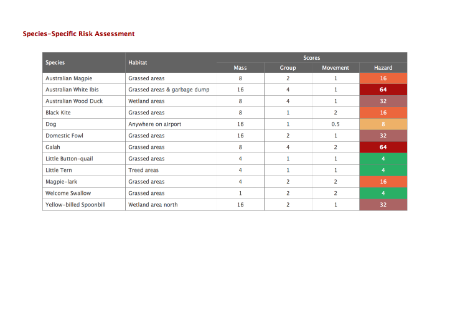Wildlife Management & SMS Integration
I may have suggested a couple of weeks ago that I was not going to carry on with material from my Indonesia trip in June but I really wanted to share this fictional case study with you. In order to highlight the interaction between strategic level SMS risk management and the more operational level risk management found in wildlife management plans, I developed the case study below. Its not really based on anything I've seen in action but more based on how I would approach the problem if anyone put me in charge.
Background
Some sources put the cost of bird-strikes at $1.2 billion dollars per year. This makes wildlife hazard management a very important task for modern airport operators. It is however, a very big issue to tackle with a great deal of variety in operating environments, wildlife species, aircraft types and resources available.
This means that a single solution or prescriptive standard can not solve this problem. Instead, we turn to risk management as a way of reducing the chance and severity of wildlife related incidents to an acceptable level. PKPS 139 requires all airport operators assess the risk relating to bird and animal hazards and to implement controls to manage the risk. Even before any formal risk management process starts every operator already has people observing the wildlife on the aerodrome and reporting strike in accordance with the regulations. In SMS terms, major wildlife hazard management activities are usually initiated by safety assurance activities such as internal audits and investigations.
Beginning at the Top
In this scenario, an internal safety audit has identified a general increase in the numbers of birds on the aerodrome, plans for a garbage dump nearby and a couple of costly bird-strikes as concerns requiring formal risk assessment. The Safety Manager presented the audit’s report to the CEO and the CEO tabled the report at the next Safety Committee meeting.
The Safety Committee initiated the risk management process at the strategic level by reviewing its previous wildlife hazard risk assessments found in its risk register. The review found that a formal hazard management plan (operational risk management) was required.
As per the review, the Safety Manager engaged a qualified ornithologist with airport experience to develop a comprehensive management plan. This plan began with a full assessment of the wildlife on and in the vicinity of the airport and the environment on and off the airport. This assessment resulted in the identification of more specific hazards including each animal species – see below for an example of this type of risk assessment based on the model published by the Australian Aviation Wildlife Hazard Group. This assessment allows for the planning of allocation of resources to the most critical areas – for example, the grassed and wetland areas are more important than treed areas and ibis and galahs require more attention than quail, tern and swallow.
From this point, the consultant works with the airport operator to identify potential risk treatments. These treatments cover a range of strategies including habitat control, feed control, harassment and reporting.
Habitat control – this strategy is targeted at the higher risk areas and species and includes longer grass in areas, filling in a number of ponds and the netting of potential nest sites.
Feed control – this includes efforts to minimise food sources such as removal of fruit trees, enclosed garbage areas, a mowing schedule to reduce grass seeding and a safety promotion campaign advising all airport users of the need to pick up rubbish.
Harassment – these efforts include a range of acoustic and visual harassment devises for airport reporting officers and a semi-irregular harassment schedule.
Reporting – two new reporting systems were proposed. The first consists of an external reporting system whereby significant wildlife hazards are reported directly to the aerodrome users’ safety/operations departments. These reports follow a standard format issued through the airside operations manager. The second system involves internal reporting of wildlife hazards according to specific risk-based triggers devised by the consultant. If during an inspection, the airport reporting officer notices a specific hazard in excess of these triggers, he/she submits a report to the Safety Manager. The regulatory requirement to report all strikes to the authorities continues to exist.
Monitoring consists of regular animal-counts typically carried out following the morning airport inspection. Tactical risk assessment consists of comparing this count results against the reporting triggers developed by the consultant (see above). Results below these thresholds are filed for future review.
These results plus records of wildlife strikes and any other report are reviewed annually along with the entire management plan. Deficiencies are identified and the plan amended as required. The results of these reviews are submitted to the Safety Committee by the Safety Manager.
More Information
link
There is plenty of information on the Internet on this issue. Here are a couple of links:
Image credit: Adrianna Calvo (via Pexels)




